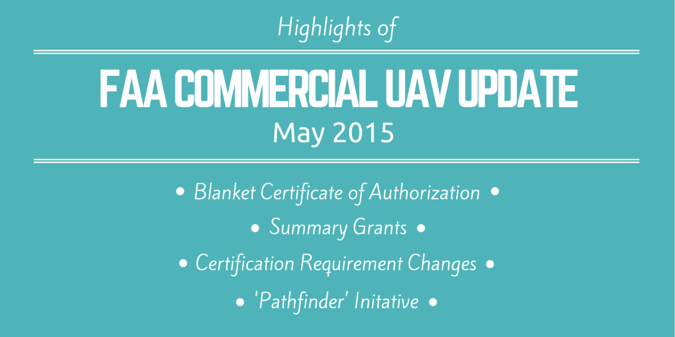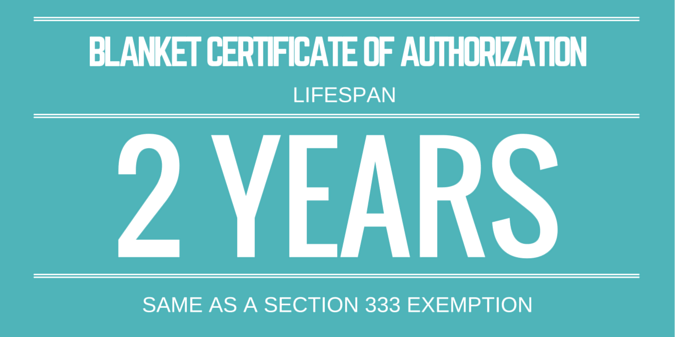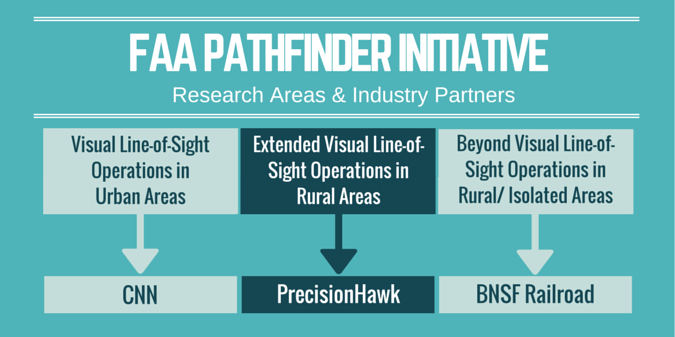Since the Federal Aviation Administration (FAA) published the Small Unmanned Aircraft Systems (UAS) Rule back in February this year (which proposed a set of regulations for flying commercial small Unmanned Aerial Vehicles (UAVs)), the national aviation authority of the United States (US) have announced some updates and developments regarding the Section 333 Exemption process that will be of interest for those wanting to utilise commercial UAV operations.

According to the FAA, as of 20th May 2015 under Section 333 of the Modernization and Reform Act of 2012 there have been 416 exemptions granted compared to 44 that have been denied.
Streamlining Commercial UAS Flight Exemptions
Interim Policy of Blanket Certificate of Authorization
On 24th March 2015 the FAA announced that they had introduced an interim policy for a Blanket Certificate of Waiver or Authorization (CoA) for operators of commercial UAVs that met the following requirements:
- The UAV must weigh less than 55lb (25kg)
- The UAV cannot ascend above 200ft (60.96m)
- Operations must be kept to the daytime in Visual Flight Rules (VFR) conditions
- The operator must maintain visual line of sight (VLOS) at all times
- The UAV must stay away from aviation facilities by the distances set out below:
- “5 nautical miles (NM) from an airport having an operational control tower; or
- 3 NM from an airport with a published instrument flight procedure, but not an operational tower; or
- 2 NM from an airport without a published instrument flight procedure or an operational tower; or
- 2 NM from a heliport with a published instrument flight procedure [1]”
The 200ft maximum altitude restriction applies to anywhere in the US except within restricted airspace and other places where FAA restrictions apply such as major cities like Washington.

The interim policy supersedes the earlier process which required a UAV operator to apply for a CoA for a specific area of airspace for each individual flight [2]. It also speeds up the approval process for Section 333 which previously meant that each case had to be assessed individually.
Now the CoA will last for the same amount of time as a Section 333 exemption – 2 years – and require the operator to submit personal, UAV and malfunction information to the FAA on a monthly basis [3].
Summary Grants
Following on for the issuance of the CoAs, the 9th April saw the FAA announce the use what they termed “Summary Grants” process to further speed up the Section 333 approval process.
The Summary Grants can be issued without completing individual detailed analysis on new applications that are similar to ones that have been given approval in the past. However on its news page [4], the US aviation authority did stress that “the FAA still reviews each Section 333 petition individually”
In order for the exemption applicant to gain a summary grant they must [3]:
- “Be applying to use a UAV for a role that has been previously given approval
- Use a UAV model that has already been given an exemption before
- Abide by limitations of earlier grants
- Have all relevant supporting materials of an operator”
Certification Requirement Changes
Pilot
Along with the declaration of Summary Grants, the FAA mentioned that they had loosened the rules on the piloting certification required. Instead exemptions being granted only to operators holding a private pilot certificate, now those holding a recreational or sport pilot accreditation will be accepted also.
Medical
It is the case now that an operator petitioning for a Section 333 Exemption only “needs a valid driver’s license to satisfy the medical requirement [4]”
‘Pathfinder’ Initiative

On May 6th 2015, at a specialist UAV conference, an FAA representative announced that the authority would be working with industry partners to explore the use of small commercial UAVs in three areas [5]:
- Visual line-of-sight operations in urban areas – CNN will investigate how UAVs can safely operate for news-gathering.
- Extended visual line-of-sight operations in rural areas – UAV manufacturer PrecisionHawk will advance the research around uses of these systems in agriculture.
- Beyond visual line-of-sight in rural/isolated areas – Large North American freight train operator BNSF Railroad will explore challenges of using UAVs for inspecting rail infrastructure.
Despite not being directly related to a change in the Section 333 Exemption process, the initiative shows that the FAA is taking steps to develop its strategy for commercial UAV use.
Conclusions
It is no secret that the popularity, technological capabilities and large commercial application of UAVs is evolving fast. Unfortunately for the regulatory bodies, such as the FAA, this means that there is an expectation for them to adjust safety guidelines accordingly and at the same pace.
From the number of Section 333 Exemption changes that have happened in the last 3 months, it suggests that the FAA are proactively trying to find ways to increase the speed at which they deal with requests as well as forward think about the future of UAV technology with the new ‘pathfinder’ initiative.
It will be interesting to see what will change as the year progresses, what do you think will happening next? Have we missed any updates?
References
[1] FAA Streamlines UAS COAs for Section 333, FAA, (Last accessed 20/05/2015)
[2] FAA Blanket COA Eases Restrictions on Commercial UAS Operations, Juliet Van Wagenen, (Last accessed 20/05/2015)
[3] Section 333 Exemption Process: What Has Changed, And How Can You Take Advantage Of It?, McKenna Long & Aldridge LLP, Slide 8, (Last accessed 20/05/2015)
[4] FAA Summary Grants Speed UAS Exemptions, FAA, (Last accessed 20/05/2015)
[5] Press Release – FAA – Industry Initiative Will Expand Small UAS Horizons, FAA, (Last Accessed 21/05/2015)
